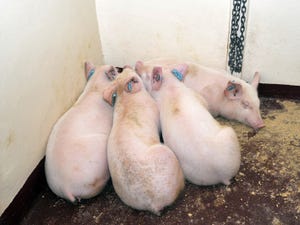Group sow housing: The Quebec report
For a properly prepared and defined transition to group housing, certain factors must be considered before undertaking the project
November 2, 2015
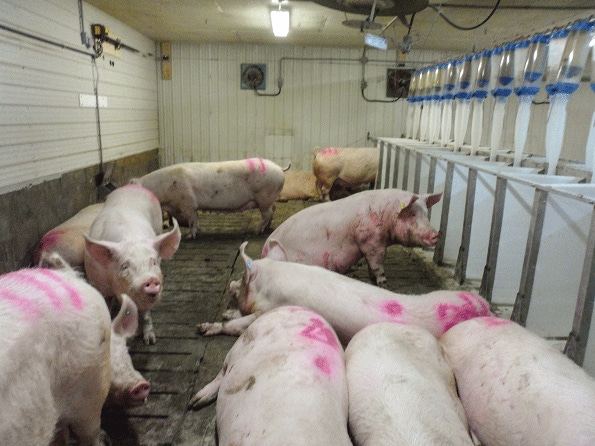
To document the first retrofitting of swine barns to group-house gestating sows, staff from the Centre de développement du porc du Québec (Development Centre of Quebec Pork Inc.) visited eight Quebec farms with different feeding systems, two farms for each system. The systems were:
Floor feeding
Free-access, non-gated stalls
Electronic sow feeding
ESF self-locking, gated stalls
Floor feeding
This is the simplest and cheapest system; all sows feed straight off the floor at the same time. Retrofits can be done quickly. However, feeding sows individually is impossible.
Recommended minimum space allocation: 22 square feet per sow, to limit fights and feed waste.
Renovations: The two farms we visited were both farrow-to-finish facilities before the transition and are now farrow-to-wean. In both cases, the finishing unit was modified to accommodate group-housed sows. To achieve this, the solid floors over two-thirds of the area were left intact, since it was ideal for floor feeding. Since concrete is a sturdy material that’s well able to support the weight of sows, the concrete pen dividers were also kept. The pens were converted by simply removing the troughs and perforated barriers between two finishing pens.
This U-shaped layout divides the pen into two separate sections, allowing subordinate sows to go eat in the section opposite to the one where the dominant sow of the group is standing.
Several drop feeders per pen were installed to distribute the rations over a larger area and reduce competition for the feed. It is important to provide enough feed to distribute only one meal a day. Mealtime is stressful, especially for the animals of lower social rank. Water bowls were added according to the prescribed ratio of one bowl for every 10 to 15 sows.
Investment costs: Costs were $30 per place in a group-housed gestation unit (first producer) and $58 per place (second producer).
Cost excludes labor costs. (Owners and their employees did part of the work.)
Management: With floor feeding, it is impossible to control what each sow consumes. For this reason, it is important to form groups of 15 to 20 sows that are as uniform as possible (parity, weight and body condition). Having uniform groups reduces competition between sows, and the producer can better control the amount of feed distributed in a pen, according to the body condition of the sows in it.
Both producers believe it is important to use the time when sows are in gestation crates (35 to 42 days) to bring the thin sows back into good condition.
The producers explained that when they do not abide by the recommended minimum space allocation (22 square feet), they notice increased competition for the rations. Subordinate sows are shy and fearful, and they are often the last to eat, so they end up becoming thin because they do not get enough to eat.
The producers commented:
They were very happy with this new herd management system; they prefer it to the old way.
Their sows are much calmer and easier to handle.
The sows performed well.
However, group-housed sows that have spent their entire lives in crates are more difficult. They have not learned to interact with other sows, resulting in increased aggression in the first groups. Plus, producers mentioned that they tend to overfeed, to keep the smallest sow in the group in good condition. This practice can mean that more than 100 kilograms (220 pounds) of extra feed per sow per year are distributed, compared to feed management in gestation crates. That’s an additional cost to consider.
For various reasons, 5% to 15% of sows will need to be removed from the group. So, it’s important not to underestimate the number of places allocated for housing problem sows.
Non-gated short stalls
This simple and inexpensive system, allows sows to feed simultaneously in a trough or on the floor. Sows are protected by dividers (shoulder barriers), which theoretically reduce aggression and feed spillage. However, it is impossible to feed the sows individually, which results in some feed waste.
Minimum recommended space allocation: 20 to 22 square feet per sow, to limit fights and feed spillage.
The usable space does not include the space assigned to the short stalls.
Renovations: The producer on the first farm visited modified a part of the crated gestation area to group-housed sows, using the non-gated, short-stall system.
All the equipment was removed except the automatic delivery feeder and the drop feeders. The concrete slats were changed. Then, concrete barriers were positioned to separate each pen and also separate the central aisle from the pens. These barriers between pens serve to support the shoulder barriers comprised of plastic panels, stainless-steel stanchions and bolts. Finally, water bowls (ratio of 1:12) were installed.
Cost of materials and equipment: Cost was $134 per place in a group-housed gestation unit. Cost excludes labor costs.
The installation of equipment is extremely time-consuming and represents an additional $40 to $50 per short stall.
The second farm visited was formerly a farrowing facility with a nursery area. Here the nursery unit was modified to group-housed gestating sows. All equipment in the former nursery area was removed. The floors were modified to install concrete slats. First an angle iron was installed on the gutter walls to form the base for the concrete slats. Next, a 4-inch-high concrete slab was poured in the center of the area. This created a slightly raised eating area for the sows, encouraging them to stay in their place and giving fewer chances for the inside of the stall to get dirty. A low concrete wall was set on the concrete slab to separate the groups. At the same time, it formed a rigid support for the shoulder barriers comprised of plastic panels, stainless-steel stanchions and bolts. Finally, each group of 17 sows was given one water bowl.
Total cost was $266 per place in a group-housed gestation unit. The cost includes changing the floor (43% of the total cost). It excludes labor costs.
Management: The key to success with this system is to form uniform groups of sows according to the body condition, size and parity of the sow when the gilts are housed together. Making good use of the time when the sows are in gestation crates to bring them back into good condition is crucial. For feed, producers should serve one meal a day of more high-fiber rations and ensure they are present during feeding time. High-fiber rations are beneficial: the greater the volume of feed distributed, the longer the feeding time. This lets slower-eating sows consume a large amount before the dominant sows start stealing the rations. Also, eating a large volume of feed increases the sows’ sense of fullness, decreasing the number of fights.
Producers commented:
They were very satisfied with the short-stall system: Sows are in good condition with good performance.
Sows are calmer and in great shape at the start of farrowing.
The first group formation is more difficult for sows that have only known crates.
These sows have more difficulty adjusting to the group lifestyle than to the new feeding system.
ESF system
In an electronic sow feeding system, each sow is identified by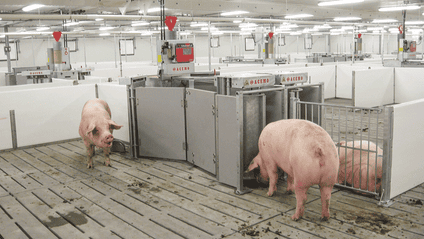 a microchip as she enters the feeder. This has several advantages, including individualized feeding of sows, the ability to distribute many types of rations, to sort and mark (paint line) the appropriate sows and to consult the herd’s feeding data remotely. However, because of its high cost, ESF is not the ideal system for a small herd.
a microchip as she enters the feeder. This has several advantages, including individualized feeding of sows, the ability to distribute many types of rations, to sort and mark (paint line) the appropriate sows and to consult the herd’s feeding data remotely. However, because of its high cost, ESF is not the ideal system for a small herd.
Renovations: The first farm visited changed its purpose during the transition, going from farrow-to-finish to farrowing only, by changing the finishing unit.
To have a group-housed gestation unit on this farm, the compromise reached was to keep the existing finishing unit floors (two-thirds slats, one-third solid), thereby reducing costs by around 40%. The downside: Some sections of the solid floor are not
located in the right place, which leads to some confusion in sows as to how they use it. Sows prefer to lie on a solid floor and lean against a solid wall, so pen dividers were positioned at strategic locations to encourage sows to lie there.
Certain finishing unit equipment was reused, such as the transmission (gearbox) of the automatic feeder, and the plastic panels and stanchions. These were used to create the dividers between each lying area.
Total cost was $532 per place in a group-housed gestation unit.
Cost includes:
Purchase of ESF
Water bowls
Materials needed to change pens and structure
Cost excludes labor costs.
On this farm, multiparous sows are managed in static groups (all sows are from the same batch), while gilts are managed in dynamic groups (sows from different batches and at various stages of gestation within the same group). This prevents unfair competition for access to the ESF since all animals in the group are roughly the same size. Dynamic management allows gilts to develop better social behavior and to adapt better to group life.
The project on the second farm is different from the others; it is the type of project
common in Europe. The aim was to amortize transition costs by increasing the number of productive sows and, in particular, to optimize the existing building without renovating it. To achieve this, a new building (group-housed gestation unit, new farrowing areas) and a quarantine unit were built. Following this transition, the number of productive sows increased from 1,000 to 2,400. During the work, the herd of 1,000 sows proceeded with its usual rotation.
In this type of transition, the gestation crates from the existing building become the breeding section of the 2,400-sow gestation unit. The new group-housed gestation barn includes 10 pens containing 120 gestating sows, managed in a static group. Each pen is divided into two, for housing the batch of gilts separately from the multiparous sows.
Total cost is $1,815 per sow (for the herd of 1,400 new productive sows).Cost includes a farrowing area and a quarantine unit.
Management: Training the animals to access the ESF system is crucial to its success. This training period takes seven to 10 days so that all sows are confident in using the system. Sows are “forced” to access the feeding station every two or three days. The success rate is between 96% and 99%.
During group formation, fights are inevitable because the group hierarchy has yet to be established. However, given the layout and size of the pens, a sow can easily move away and avoid the fight.
The ESF system makes excellent control of sow body conditi
on possible by using different feed curves. Because the right amount of feed is distributed to the right sow at the right time, there is even a savings of up to 250 grams in feed rations over crated housing systems.
The daily work connected with the ESF system is completely different from the work connected with a crated system. One of the first actions carried out in the morning is to check which sows have not eaten and to identify those sows in the pens. The daily walk through the pens builds a trusting relationship between sows and stockperson.
According to producers, this system does not result in less work time. Rather there is extra work compared to management of a crated system, due to the sow training.
ESF system with self-locking stalls
This type of system is similar to the standard ESF, but 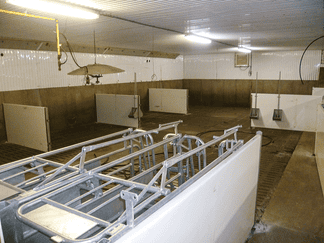 simpler. The stall mechanism is triggered by the sow, not by compressed air. Unlike the standard ESF, sows enter and leave through the same gate. This system has almost all the advantages of the
simpler. The stall mechanism is triggered by the sow, not by compressed air. Unlike the standard ESF, sows enter and leave through the same gate. This system has almost all the advantages of the
standard ESF while being simpler and less expensive. Sow training is done much more easily than for the standard ESF, and its ratio of 20 sows per self-locking ESF feed station means it is adaptable to any size of farm. However, this system is still in development and still has to be tested.
Renovations: The first farm visited went from farrow-to-finish to farrow during the transition. To group-house sows in the finishing unit, floors were left untouched. Here the compromise was that the lying area in the finishing unit became a movement area. This resulted in animals using this space for defecation and urination. The area is messy, slippery and causes sore feet.
This example demonstrates that it is better to invest a little more in renovations to ensure a smooth operation, rather than living with a compromise that is difficult to resolve and expensive in the long term. To organize the pens, the plastic dividers and stanchions from the finishing unit were reused.
Water bowls were installed in accordance with the ratio of one bowl per 10 sows. Pass-through gates (an in-house design: stile) allow staff to enter and leave the pens without manipulating gates or climbing over pen dividers.
Total cost was $147 per space in a group-housed gestation unit. Cost includes:
Purchase of ESF self-locking stalls
Water bowls
Materials for changing the pens
Cost excludes labor costs (estimated at around $15 per place).
For the second farm, a crated gestation unit was modified to house the ESF self-locking system. The first step was to dismantle all the equipment in this gestation unit: gestation crates, pen dividers, feeders (dispensers), drop boxes and automatic feeders. Next, the feed augers were removed and the concrete under them re-laid to obtain a flat surface.
The next step was to cap the manure pits under the concrete slats in the gestation unit using long, galvanized metal sheets. To attach these metal sheets, several methods have been tried in some facilities: T-bolts, PL adhesive and stainless-steel rivets. This last method appears to be the most promising (it holds for more than three years). The equipment and pen dividers were then installed.
Total cost was $286 per place in a group-housed gestation unit.
Cost includes:
Purchase of ESF self-locking stalls
Water bowls
Panels and stanchions for the pen dividers
Minor changes to floor
Cost excludes labor costs (estimated at $22 per place).
Management: Producers report that 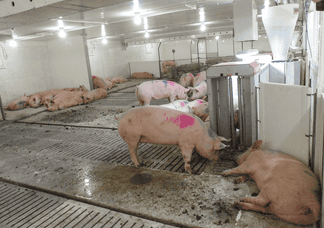 sows learn quickly how to operate the system. Over 95% of gilts learn the system by themselves in less than three days. The stockperson has only to train 5% of the sows, and almost all of them know how the feeding system works after their first trial run.
sows learn quickly how to operate the system. Over 95% of gilts learn the system by themselves in less than three days. The stockperson has only to train 5% of the sows, and almost all of them know how the feeding system works after their first trial run.
As in the ESF system, stockpersons enter all the pens regularly, developing a trusting relationship with the animals and facilitating their later handling.
Both farms use many feeding curves to ensure optimum control of sows’ body condition.
Conclusion
For a properly prepared and defined transition to group housing, certain factors must be considered before undertaking the project: Is an increase or decrease in sow inventory expected? Is the business to become specialized (shifting from farrow-to-finish to farrow 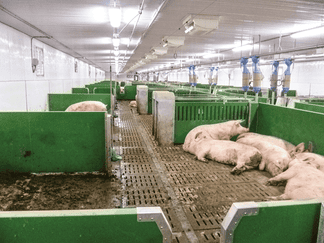
only)? Is the business to stay the same size? Are other projects possible?
You must check regulatory restrictions in force in the sector and comply with existing environmental standards. Then you have to learn about the different animal welfare standards and buyer requirements, as well as determine what group housing system you want.
Check that you can alter existing buildings to achieve your objectives. Sometimes it is more advantageous to build new than to retrofit an existing building. Finally, know what this transition will cost and make sure your financial situation allows implementation of the project.
Multiple drop feeders were installed over pens, distributing rations over a larger area to reduce competition for feed.
Grouping sows according to body condition, size and parity is key to the success of a group housing system.
An electronic sow feeding system offers producers several advantages: individualized feeding for sows and the ability to distribute many types of rations and sort and mark appropriate sows.
Sows prefer to lie down against a wall, so pen dividers were installed at strategic locations to encourage sows to lie there.
Quebec producers say you will be disappointed if you simply turn the sows loose in an electronic sow feeding system, as it takes a seven- to 10-day training period before sows are confident in using the system.
Plastic dividers and stanchions from a former finishing unit were used to organize pens in this renovation.
Transition to a grouped-housing system will require many management considerations, as well as evaluating the operation’s ability to take on the renovation of an existing facility or new construction.
You May Also Like
